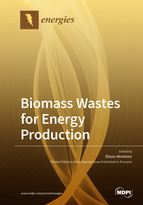Biomass Wastes for Energy Production
A special issue of Energies (ISSN 1996-1073). This special issue belongs to the section "A4: Bio-Energy".
Deadline for manuscript submissions: closed (31 December 2020) | Viewed by 37342
Special Issue Editor
Interests: biomass; waste-to-energy; gasification; combustion; CFD
Special Issues, Collections and Topics in MDPI journals
Special Issue Information
Dear Colleagues,
Environmental problems are forcing a rethinking of the world’s energy supply system. In parallel, there is an increasing amount of global solid wastes production. A fundamental shift toward greater reliance on biomass wastes in the world’s energy system is plausible because major technological advances are ongoing that hold the promise of making the conversion of biomass into high-quality energy carriers, like electricity and gaseous or liquid fuels economically competitive with fossil fuels. Therefore, waste-to-energy systems have become a topic of paramount importance for both industry and researchers due to interest in energy production from waste and improved chemical and thermal efficiencies with the more cost-effective designs. This biomass shift is also important for industries to become more efficient by using their own wastes to produce their own energy in the light of the circular economy concept.
This Special Issue on “Biomass Wastes for Energy Production” aims to publish novel advances of waste-to-energy technologies from experimental and computational perspectives. Topics include but are not limited to:
- Biomass wastes: availability, characterization, and role on circular economy;
- Progress in waste-to-energy technologies;
- Computational models for biomass-based energy generation;
- Cost and performance analysis of waste-to-energy technologies;
- Life cycle analysis of waste-to-energy technologies.
Prof. Dr. Eliseu Monteiro
Guest Editor
Manuscript Submission Information
Manuscripts should be submitted online at www.mdpi.com by registering and logging in to this website. Once you are registered, click here to go to the submission form. Manuscripts can be submitted until the deadline. All submissions that pass pre-check are peer-reviewed. Accepted papers will be published continuously in the journal (as soon as accepted) and will be listed together on the special issue website. Research articles, review articles as well as short communications are invited. For planned papers, a title and short abstract (about 100 words) can be sent to the Editorial Office for announcement on this website.
Submitted manuscripts should not have been published previously, nor be under consideration for publication elsewhere (except conference proceedings papers). All manuscripts are thoroughly refereed through a single-blind peer-review process. A guide for authors and other relevant information for submission of manuscripts is available on the Instructions for Authors page. Energies is an international peer-reviewed open access semimonthly journal published by MDPI.
Please visit the Instructions for Authors page before submitting a manuscript. The Article Processing Charge (APC) for publication in this open access journal is 2600 CHF (Swiss Francs). Submitted papers should be well formatted and use good English. Authors may use MDPI's English editing service prior to publication or during author revisions.
Keywords
- biomass wastes
- waste-to-energy technologies
- thermodynamic and CFD analysis
- life cycle analysis






